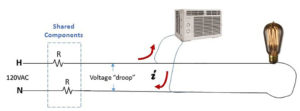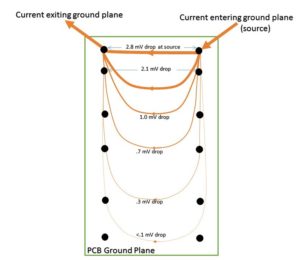Common-impedance coupling occurs when two or more circuits share a common ground and is the result of a shared impedance in a shared ground path. The best way to explain it is by way of a common example, such as when the lights dim when an air conditioner is turned on; they probably share the same wire for the return current. The shared wire represents an impedance that is common to both the light fixture and the AC unit. The path of current through the resistors is the same path of current for the light bulb.
Anytime the AC motor’s current path and the light fixture’s current path overlap in shared components, the current multiplied by the impedance of the components (resistor) determines the value of the voltage dip that the downstream device (light bulb) experiences as a result of the upstream current draw (motor). The motor turns on, and the light dims momentarily. “Voltage droop” can be measured to show the lower than expected voltage potential for the light bulb, which causes the dimming.

In a PCB ground plane, the effect of current flowing through the ground plane is experienced differently at different points in the ground plane. For a sensitive analog signal, the PCB ground plane is “infected” with varying currents and voltage noise, and there is no ideal ground plane in reality. It is necessary to know the actual path that a current signal takes in its return path through the ground plane if EMC noise is to be avoided. For digital designs, a .1mV noise source doesn’t register. But for very sensitive analog signals, a millivolt can be a noise problem. From the analog perspective, if there’s a lot of current flowing through one portion of a PCB ground plane, it’s prudent to move away from that area of the board to avoid noise. In other words, circuits with large differential power levels on a common PCB should avoid the same ground return path.

The problem compounds if there is a high-frequency signal involved, as in general, ground inductance becomes dominant above 1MHz in the ground plane of the PCB example in Figure 2. For high-frequency signals (generally above 100kHz), multi-point ground systems should be used to minimize the ground impedance and inductance. For current signals with frequencies below 1MHz (for audio interference), current in the reference plane will flow through the least resistive path. Above 1MHz (for radio signal interference), it tends to flow the least inductive path.
Thus, current signals at lower frequencies are dominated by common-impedance coupling. Current signals at higher frequencies are dominated by common-inductive coupling. However, the size of the structure also plays a part in both cases. The “boundary frequency” where the signal becomes more influenced by shared inductance differs according to physical size. For example, with small integrated circuits, the “boundary frequency” where low frequency impedance-dominated current flow gives way to high frequency inductive-dominated current flow is around 20GHz. For larger structures like transmission towers, the boundary between low frequency resistive-dominated current flow and high frequency inductive-dominated current flow happens below 60Hz.
